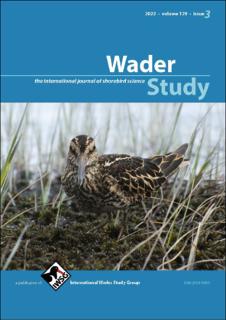The breeding ecology of Broad-billed Sandpipers in northern Norway
Peer reviewed, Journal article
Published version

Åpne
Permanent lenke
https://hdl.handle.net/11250/3042351Utgivelsesdato
2022Metadata
Vis full innførselSamlinger
- Publikasjoner fra CRIStin - NINA [2364]
- Scientific publications [1392]
Originalversjon
10.18194/ws.00289Sammendrag
The breeding ecology of the Broad-billed Sandpiper Calidris falcinellus was investigated in a long-term study in Finnmark, north Norway during 1993–2019. Nests were mostly located and monitored during the incubation period. We found a total of 173 nests with annual variation of 2–14 nests per year. All nests were located in wet quaking fens in aapa mires. The mean laying date was 10 June (annual mean estimates: 1–24 June) and was earlier in years with warmer temperatures in early June. Most clutches contained four eggs (94%). Daily nest survival was 0.9838 ± 0.0057 SE (Mayfield method, 8 losses in 494 days of exposure), which gave a high probability of nest success of 0.665 ± 0.096 SE for a 25-day nesting cycle. Most nest failures were due to flooding. The cause of annual variation in the number of breeding pairs was unclear, although nest success was correlated with weather and associated environmental conditions. Broad-billed Sandpipers started breeding in their second calendar year, and returning birds showed strong pair and nest-site fidelity, often breeding in subsequent years with the same partner in the same mire and reusing the same nest scrape. Broad-billed Sandpipers are elusive in their breeding behaviour and occupy a highly distinctive and localised breeding habitat, which was often treacherous to survey. General wader surveys based on transect methods are likely to be ill-suited for estimating population numbers for this species. aapa mires Calidris falcinellus Finnmark nesting success site fidelity wader survey
